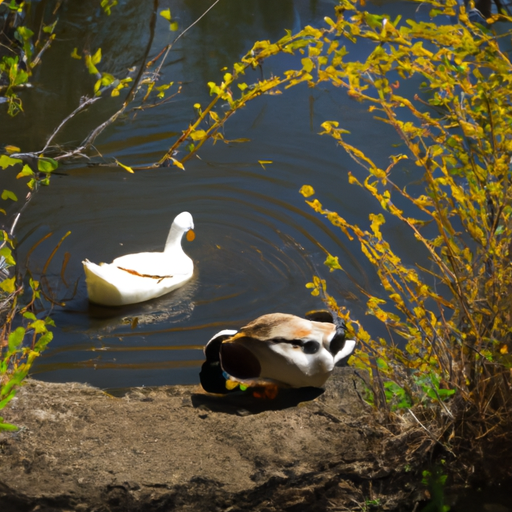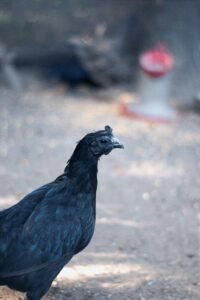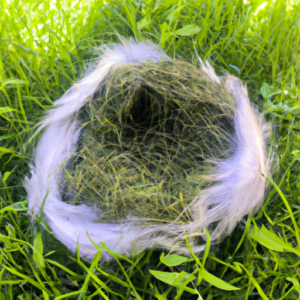
Are you wondering about the best approach to introduce ducks to your existing chicken flock? The process of integrating ducks and chickens can be both exciting and challenging. Understanding the dynamics between these two species and implementing proper techniques is crucial for a successful introduction. In this article, we will explore the various methods and strategies that can help you create a harmonious coexistence between your ducks and chickens.
Understanding the Differences Between Ducks and Chickens
Ducks and chickens may both be popular poultry choices, but they have several distinct differences that are important to consider before integrating them into the same flock. One notable difference is their body size and weight. Ducks are typically larger and heavier than chickens, which can impact their foraging behavior, water requirements, and even social dynamics. Understanding these differences is crucial for a successful integration process.
Body Size and Weight
When it comes to body size and weight, ducks surpass chickens. Ducks are generally larger and heavier, which means they require more space and resources. Their larger size can also affect their ability to maneuver within the flock and may have an impact on feeding and drinking arrangements. On the other hand, chickens, although smaller, are often more agile and can navigate more easily within the flock.
Foraging Behavior
Another aspect where ducks and chickens differ is their foraging behavior. Ducks are natural foragers and have a strong preference for moist environments. They enjoy rooting around in damp soil, searching for insects and vegetation. Chickens, on the other hand, tend to forage more on dry land, pecking at the ground to find food. Understanding these behavioral differences is essential when designing the environment for integrated flocks.
Water Requirements
Water is a vital element for ducks, as they not only enjoy foraging in wet areas but also require regular access to water for grooming and maintaining moisture in their feathers. Ducks need deeper water sources, such as ponds or shallow pools, where they can fully submerge themselves to clean their plumage. Chickens, on the other hand, have less stringent water requirements and can make do with shallow water dishes. Providing appropriate water sources is crucial for meeting the needs of both ducks and chickens.
Social Structure
Ducks and chickens have different social structures within their respective flocks. Chickens tend to form strict hierarchies, with a dominant pecking order. They establish a rigid social order based on size, age, and dominance. Ducks, on the other hand, have a more egalitarian social structure and tend to be less aggressive. Understanding these social dynamics can help ensure the smooth integration of ducks into an existing chicken flock.
Behavioral Differences
Apart from their differences in body size, foraging behavior, water requirements, and social structure, ducks and chickens also differ in several other behavioral aspects. Ducks are known for their quacking sounds, while chickens have distinct clucking noises. Ducks are also more likely to explore their surroundings, often venturing further away from the flock, while chickens tend to stay closer together. By understanding these behavioral differences, flock owners can effectively manage the integration process and promote harmonious relationships among the birds.
Benefits of Introducing Ducks to a Chicken Flock
Introducing ducks to a chicken flock can bring about numerous benefits for both the flock’s management and overall productivity. These benefits include natural pest control, improved foraging, enhanced social dynamics, and increased egg production. By carefully introducing ducks, flock owners can capitalize on these advantages and create a more balanced and productive environment for their birds.
Natural Pest Control
One of the significant advantages ducks bring to a chicken flock is natural pest control. Ducks have an innate ability to consume various types of pests, including insects, slugs, and snails. They are voracious eaters and can help control pest populations that may otherwise harm the chickens or have negative effects on the environment. By integrating ducks into the flock, flock owners can reduce the need for chemical pest control methods and promote a healthier ecosystem.
Improved Foraging
Ducks’ foraging behavior can greatly benefit the overall foraging activities of the flock. Ducks have a natural inclination to root around in moist soil and water, providing an opportunity for them to uncover and consume hidden food sources. This behavior can lead to improved foraging for chickens as well, as they may follow the ducks, picking up leftovers or finding new food items that they might have missed before. Introducing ducks to the flock can expand the birds’ foraging opportunities and lead to a more diverse and fulfilling diet.
Enhanced Social Dynamics
Integrating ducks into a chicken flock can also enhance the social dynamics within the group. Ducks’ more relaxed and less aggressive social structure can help alleviate some of the competitive behaviors often seen among chickens. The presence of ducks can create a more peaceful environment and promote a sense of camaraderie among the birds. This enhanced social interaction can contribute to the overall well-being and happiness of the flock.
Increased Egg Production
Another advantage of introducing ducks to a chicken flock is the potential for increased egg production. Ducks have a unique laying pattern, often laying their eggs early in the day, while chickens typically lay later in the morning. By combining the two flocks, flock owners can potentially have a more consistent and prolonged egg-laying schedule. This increased egg production can be beneficial for personal use or commercial purposes.
Preparing the Environment for Integration
Before introducing ducks to an existing chicken flock, it is essential to prepare the environment to ensure a smooth transition and minimize potential conflicts or issues. Several key factors need to be considered, including securing the enclosure, providing sufficient space, ensuring water access, creating shelter options, and adjusting feeding arrangements. By addressing these aspects, flock owners can create a suitable environment that caters to the needs of both ducks and chickens.
Securing the Enclosure
The first step in preparing the environment for integration is to secure the enclosure. Ducks, although larger and heavier than chickens, are more vulnerable to potential predators due to their slower movement on land. Fences with smaller gaps or mesh wire can help prevent predators from entering the enclosure and keep the birds safe. Additionally, reinforcing the base of the fence to discourage digging is crucial, as ducks have a tendency to explore and may attempt to escape if given the opportunity.
Providing Sufficient Space
Both ducks and chickens require adequate space for their well-being and to promote a harmonious living environment. Ducks typically need more space per bird compared to chickens due to their larger size and greater activity levels. As a general rule of thumb, providing at least 10 square feet per duck and 4 square feet per chicken is recommended. Sufficient space allows the birds to move comfortably, engage in natural behaviors, and avoid overcrowding-related issues.
Ensuring Water Access
Water access is a critical consideration when integrating ducks into a chicken flock. Ducks require accessible and suitable water sources for grooming, drinking, and maintaining their overall health. This can be achieved by providing shallow pools, ponds, or water dishes specifically designed for ducks. It is essential to ensure that the water sources are easily accessible for the ducks without causing any inconvenience or safety concerns for the chickens.
Creating Shelter Options
Creating suitable shelter options is vital to accommodate the unique needs of both ducks and chickens. Ducks require shelter to protect themselves from extreme weather conditions, predators, and even the sun. Providing a separate shelter or designated areas within the existing coop where ducks can retreat to is necessary. Designing shelters with different entrances and exits can help prevent any potential territorial disputes among the birds and ensure their overall safety and well-being.
Adjusting Feeding Arrangements
Integrating ducks into a chicken flock may require adjustments to the feeding arrangements within the enclosure. As ducks enjoy foraging in wet environments, placing feeders in dry areas accessible to both ducks and chickens is recommended. It is essential to monitor the feeding process to ensure that all birds have fair access to food and prevent any aggressive behaviors or dominance issues. Adequate feeder space and multiple feeding stations can help minimize food competition between the different bird species.
Introducing Ducks to Chickens Gradually
Integrating ducks into an existing chicken flock should be done gradually and with careful consideration to minimize potential stress or conflicts between the birds. Following a step-by-step process that includes quarantine and observation periods, visual introductions, physical separation with visual contact, and gradual interaction under supervision can help ensure a smooth integration and positive social dynamics between ducks and chickens.
Quarantine and Observation Period
Before introducing ducks to an existing chicken flock, it is crucial to quarantine the ducks for a period of observation, typically around two to three weeks. This allows the flock owner to assess the health of the new ducks and ensure they are not carriers of any contagious diseases that could harm the existing flock. During this quarantine period, it is recommended to closely monitor the ducks’ behavior, feed, and observe any signs of illness or potential issues.
Visual Introduction
After the quarantine and observation period, a visual introduction can be done to familiarize the ducks and chickens with each other’s presence. This can be achieved by placing the ducks in a separate but visible enclosure within the existing chicken flock’s vicinity. This allows the birds to observe and become accustomed to one another without any direct physical contact.
Physical Separation with Visual Contact
The next step in the integration process involves physical separation with visual contact. This can be done by dividing a part of the existing enclosure or coop using a wire mesh or fence that allows visual interaction but prevents direct physical contact between the ducks and chickens. This phase allows the birds to get accustomed to each other’s presence while maintaining a level of physical separation to avoid potential conflicts or pecking order disputes.
Gradual Interaction under Supervision
Once the ducks and chickens are comfortable with each other’s presence, gradual interaction under supervision can be introduced. This involves supervised access to the same area or enclosure where ducks and chickens can interact directly. Close monitoring is necessary during this phase to ensure that the integration process continues smoothly and to address any potential conflicts or aggressive behaviors that may arise. Gradual interaction allows the birds to establish their own social order and dynamic, ensuring a balanced and harmonious coexistence.
Managing Potential Challenges and Risks
Integrating ducks into a chicken flock may present certain challenges and risks that need to be carefully managed to maintain the well-being and safety of the birds. Some of the potential challenges include aggressive behavior, food competition, disease transmission, overcrowding, and mating and breeding challenges. By understanding and implementing appropriate strategies, flock owners can mitigate these risks and foster a healthy and harmonious integrated flock.
Aggressive Behavior
Aggressive behavior can be observed when introducing ducks to a chicken flock, especially during the establishment of a new pecking order. It is essential to closely monitor the birds’ interactions and intervene if any aggressive behavior or bullying becomes excessive. Providing sufficient space, multiple feeding stations, and ensuring that the birds have opportunities for individual retreat can help minimize aggressive behaviors and promote a more peaceful coexistence.
Food Competition
Food competition can arise when combining ducks and chickens, as their feeding behaviors and dietary needs may vary. Ducks’ propensity for foraging in water or wet environments can sometimes result in chickens missing out on their fair share of food. To address this issue, ensuring ample feeder space and placing feeders in locations that are accessible to both ducks and chickens can help minimize food competition. Regular monitoring of feeding sessions and adjusting feeding arrangements as needed is essential to ensure all birds are adequately nourished.
Disease Transmission
When integrating ducks into a chicken flock, there is a risk of disease transmission between the two bird species. Ducks can carry certain diseases, such as avian influenza, for which chickens may have limited immunity. Quarantining and observing new ducks prior to integration and implementing effective biosecurity measures, such as regular cleaning and disinfection of the enclosure, are crucial to minimize the risk of disease transmission. Consultation with a veterinarian is recommended to ensure the health and well-being of the integrated flock.
Overcrowding
Integrating ducks into an existing chicken flock may lead to overcrowding if the enclosure is not adequately sized. Overcrowding can result in increased aggression, stress, and potential health issues for the birds. Providing sufficient space, as mentioned earlier, is crucial to prevent overcrowding-related problems. Regularly monitoring the flock’s behavior and overall well-being can help identify signs of overcrowding and the need for any necessary adjustments to the living environment.
Mating and Breeding Challenges
Ducks and chickens have different mating and breeding behaviors, which may present challenges when integrating the two species. Male ducks, known as drakes, can exhibit aggressive mating behaviors and may inadvertently harm chickens during mating attempts. To mitigate these risks, ensuring adequate space and providing separate nesting areas or boxes can help minimize male aggression towards chickens. Additionally, closely monitoring mating behaviors and separating any individuals exhibiting excessively aggressive behavior may be necessary to maintain the safety and well-being of the flock.
Monitoring and Evaluating the Integration Process
Once ducks have been successfully integrated into a chicken flock, it is important to continue monitoring and evaluating the integration process. Regular monitoring of health and behavior, assessing feeding and watering arrangements, observing social interactions, and tracking egg production and quality are essential to ensure the ongoing success and well-being of the integrated flock.
Monitoring Health and Behavior
Regularly monitoring the health and behavior of the integrated flock is crucial to identify any signs of illness, stress, or potential issues. This can be done through visual observation, assessing physical condition, and noting any changes in behavior or feeding patterns. Early detection of health concerns allows for timely intervention and appropriate veterinary care, ensuring the overall health and vitality of the integrated flock.
Assessing Feeding and Watering Arrangements
Continually assessing the feeding and watering arrangements within the integrated flock is important to ensure all birds have equitable access to food and water. Regularly inspecting feeders and water sources for cleanliness, adjusting the number and placement of feeding stations if needed, and providing sufficient fresh water are essential to meet the daily nutritional requirements of both ducks and chickens. This ongoing assessment helps maintain a balanced diet and promotes the well-being of the entire flock.
Observing Social Interactions
Observing social interactions within the integrated flock provides valuable insights into the dynamics and relationships between ducks and chickens. Paying attention to any aggressive behavior, dominance issues, or social stress can help identify possible adjustments needed to promote a more harmonious flock environment. Addressing any concerns promptly can prevent long-term conflicts and ensure the birds are able to coexist peacefully.
Tracking Egg Production and Quality
For flock owners focusing on egg production, tracking egg production and quality is essential. Monitoring the number of eggs laid by both the ducks and chickens, as well as assessing the quality of the eggs, helps gauge the overall productivity of the integrated flock. Consistently collecting and recording data on egg production allows for better flock management and the identification of any potential issues that may impact egg production or quality.
Conclusion
Introducing ducks to a chicken flock can bring about numerous benefits, including natural pest control, improved foraging, enhanced social dynamics, and increased egg production. However, understanding the differences between ducks and chickens, as well as carefully preparing the environment and managing the integration process, are essential for a successful integration. By following the recommended gradual introduction process and monitoring and addressing any potential challenges or risks, flock owners can create a harmonious and productive environment where ducks and chickens coexist happily and thrive together.







